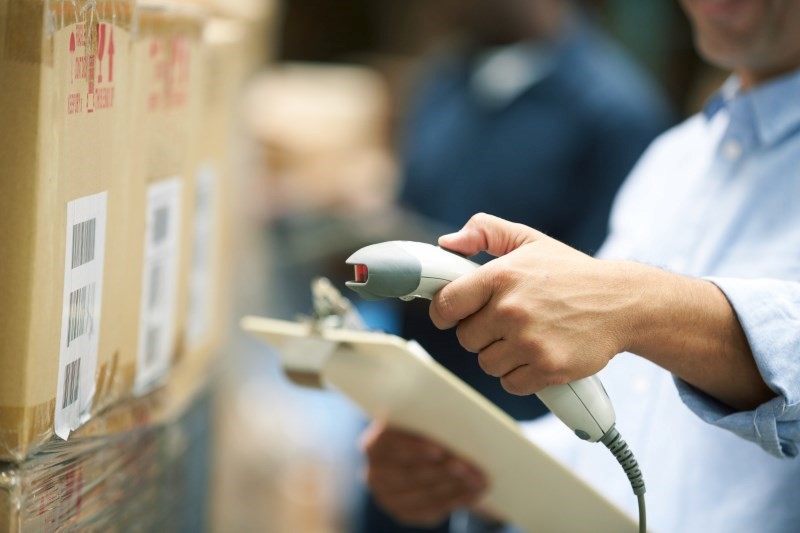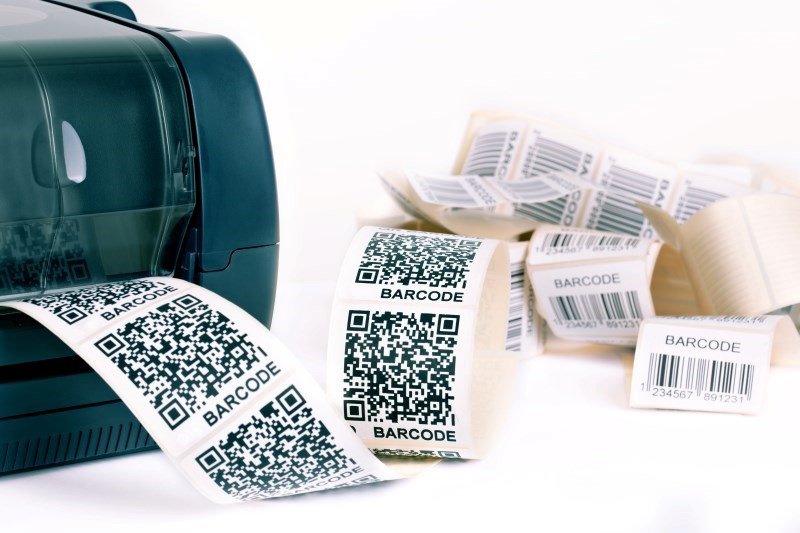The label in the logistics process is a data carrier placed directly on the product informing about the price, product features, producer and expiry date. Most often, the data contained on the label (or part thereof) is encoded with a 1D or 2D barcode.
The history of barcodes dates back to 1932 when a group of students from the University of Harvard conducted an experiment using punched cards placed in the catalogue of goods available in a store. The customer could choose the goods using a card while the cashier placed it in a reader. The goods were then delivered to the cash register where the invoice was printed and the inventory was updated. The first bar code consisted of 4 white lines on a black background. One of the first barcode scanning systems was installed in 1967 at the Krogen store in Cincinnati. Barcodes are among the most commonly used methods of labelling and identifying data.
A Barcode is a graphic representation of the information through a combination of dark and light elements determined according to the accepted rules of construction of a given code. The code enables the automatic identification of information or objects without direct human intervention. The bar code is intended for electronic readers.
One-dimensional (1D) barcodes are also known as line codes. The information is coded in one horizontal direction. It is most often used when product identification is done in a linear way, i.e. the same barcode for one product, only for identification purposes. One-dimensional codes are divided into two types: UPC (Universal Product Code) and EAN (European Article Number).
Currently, 2 types of UPC numeric codes are used: UPC-A (full) where 12 digits are coded and UPC-E (short) where 6 digits are coded.
There are two versions of the EAN code: the basic -13 digit (EAN-8) and the shortened 8-digit (EAN-8), which makes it easier to place on small packages. The EAN-8 number is only assigned in justified cases when there is no possibility of placing the EAN-13 code or for a one product producer.
Two-dimensional (2D) codes are a two-dimensional binary matrix; a graphic record of information in the form of two-dimensional images composed of black and white squares. They can be scanned using a mobile phone with a digital camera equipped with an application for reading photo codes. A two-dimensional code allows you to save much more information without increasing the code surface. In addition, a digital graphic (e.g. photo) or sound can be included in the code. A 2D code has high fault tolerance. Partially damaged 2D code can still be read correctly thanks to the implemented error correction mechanisms.
A relatively new type of barcode is the so-called ‘databar’. ‘Databar’, previously known as RSS (Reduced Space Symbology) codes, are codes introduced by the GS1 to code barcodes for small and hard to label items such as jewellery, medical or cosmetic tools or food products. The implementation of the codes was carried out in 2010. There are two main code types; the GS1 DataBar Omnidirectional and the GS1 DataBar Stacked Omnidirectional. For companies with equipment that can process more data, the GS1 DataBar Extended and the GS1 DataBar Extended Stacked will also be available. A ‘databar’ contains more data than traditional EAN / UPC codes. They provide commercially necessary information such as the net weight, product batch or expiration date, all extremely important information in food products.
Thanks to the use of barcodes, you can easily and precisely identify commercial units (goods or services), in the flow of the supply chain and be priced. They are collective and unitary goods, sold in bulk or retail on a domestic or international market.
Barcodes have also found their application in identifying the company’s fixed assets, i.e. pallets, reusable packaging or containers for storing materials.
Code use enables the identification of logistics units, i.e. those that were created for the needs of transport and are subject to identification, tracking and management processes during the flow through the supply chain.
The use of barcodes at a company causes technical improvements, significantly reducing the time needed to identify information which in turn reduces costs. Barcodes also facilitate the accounting and control work, eliminate a large amount of documentation, improve and accelerate customer service, optimise inventory work and enable automatic signalling of shortages in supply. Barcodes are used in the public sector, many branches of business and a broad range of logistics. They are used to label medicines, prescriptions, letters, parcels, websites, telephones and bills.
Barcode types
Among the available 2D codes we would like to bring to focus the following: Aztec Code and Data Matrix. The first of them was created in 1995 and two years later published under the public domain license, which means that it can be used for free. The Aztec Code is continuous and modular and has two variants, compact and full. The first allows you to write 12 decimal digits or 12 alphanumeric symbols whereas the latter allows you to write 3832 decimal digits or 3067 alphanumeric symbols.
The name Aztec Code itself is associated with its appearance as the core is in the form of a black dot surrounded by alternating black and white frames. This design makes it immediately associated with the Aztec culture element, which looks like a step pyramid from above.
The data Matrix was created in the nineties and, like the Aztec Code, is licensed under the public domain principle. The Data Matrix is two-dimensional and of variable length. Due to the fact that it consists of square modules, two types of correction codes are used:
- ECC 000-140 i.e. plexus records are most often used in radio broadcasting, telephony and satellite links.
- ECC 200 i.e. those using an error correction system, are most often used in consumer electronics as well as in data transmission technology.
Barcode printing
It often seems that barcode printing is simple and virtually effortless. At the same time, there are situations in which the scanner does not want to read a given record. The reasons for such situations are simply badly printed codes, which can cause many problems and significantly hinder control over fixed asset labelled goods. When deciding to print a one- or two-dimensional codes yourself, you should consider the quality of the equipment you buy to create labels.
It is worth knowing that we can print using three different methods: digital, thermal and thermal transfer. The first one is perfect for the production of low-volume prints; the second one allows printing only on thermal paper; while the third is ideally suited for small shops.
How to read them correctly?
It all depends on what type of code we are dealing with, either one or two-dimensional. A special device is required for reading, which will allow you to quickly decipher what is hidden under a given sign or number.
One-dimensional codes are read with a laser beam of light directed at the code. This beam allows you to estimate the distance between the lines, check their size and colour, thanks to which the photodetector can then decode them and send the information to the user.
Two-dimensional codes require laser beam imagers to read them. imagery can be used to read records in one- and two-dimensional form, while the conventional readers can only be used to read one-dimensional records.
It is important to know that an increasing number of mobile phones have applications for scanning and reading QR, but in the case of a large number of products necessary for scanning, professional equipment will work better.
Advantages of barcode use:
- One-dimensional; they enable quick verification, shorten the time of receiving and issuing, have a high accuracy of recording, lower probability of mistakes and save costs.
- Two-dimensional; they enable the recording of large amounts of information on a small surface area, are more capacious than linear, can read even partially damaged correctly, save costs and can be used in various types of marketing campaigns.
What is used to read codes?
As mentioned earlier, scanners are needed to read codes. They will allow you to locate and identify a given product. One-dimensional codes can be read simply using data because the first three digits always indicate the country of product manufacture. The next four digits for EAN-13 represent the manufacturer’s number while the last a specific product range.
As you can see, both one- and two-dimensional barcodes are widely used and make work much easier. Appropriate marking of products helps their improved and more precise classification as well as current updating of the number of items available in a warehouse or store. If you want code reading to be quick and efficient be sure to choose the right scanner and enjoy fast and comfortable work. We encourage you to familiarise yourself with our offer which offers scanners from renowned manufacturers.






